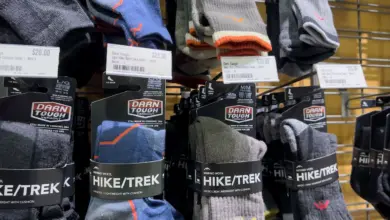Cork vs EVA Trekking Poles – Which Is Really Better?
If you’re looking to purchase trekking poles, one of the features you’ll be looking at is grip. Grips on quality trekking poles usually come in two forms, cork and EVA styles. There is a third option as well, which is rubber, but is mostly found on budget poles. Choosing the right grip material for your trekking pole usually comes down to personal preference and weather conditions. Let’s take a look at which is best.
Cork grips are considered better for most hikers. Cork offers a secure grip, wicks away moisture, and conforms to your hands over time. EVA grips absorb moisture and sweat and are not as comfortable. EVA grips are more durable and cheaper compared to cork.
Cork Grips

Cork grips are the most natural and are generally considered the best type of grip. Cork has a lot of appealing properties. It is impermeable (meaning it does not allow water to pass through), buoyant, elastic, and even fire retardant. And if you’re environmentally conscious, cork production is considered a sustainable practice as well.
But what do all these properties mean when it comes to hiking with cork trekking poles?
Cork doesn’t hold moisture, which means it will wick away sweat well and won’t hold water if it gets wet, rainy, or if you go under during a river crossing. It will though absorb a tiny bit of sweat, but not like foam. Since cork doesn’t hold moisture, there’s less chance of getting blisters and they won’t get slippery. This is especially great on long hikes in warm weather. And in colder weather, you won’t need to worry about cork freezing.
Another great thing about cork is that even though it’s elastic, it can also be formed over time. Many hikers find that with enough use, cork grips will take shape of their hands. This means you’ll have a more comfortable and improved grip and prevent blisters, even in wet conditions on long treks.
There’s a lot of good things about cork, most notably:
- Soft cool feel on hands and easier on the skin
- Resists moisture and doesn’t hold water
- Doesn’t freeze
- Conforms to your hands over time
- Offers a secure grip even in wet conditions
Not all cork grips are manufactured the same. Some of the best cork trekking poles on the market are Leki. These are extremely popular hiking poles and for good reason.
My first pair were Leki and I still have them after 8 years. They have lifetime guarantee. I put them a lot of tough terrain including the White Mountains of NH and Mount Hood. They have been rebuilt once a few years ago and fixed once this year and it has never cost me a penny. Whatever you buy, ask about the warranty. I have seen a lot of broken poles out there and Lekis would be replaced under warranty but I have never seen a pair break.
Interested in a pair of Leki trekking poles? Check them out at Amazon.com or REI.com.
Cork grips can vary in quality as well. Some hikers use cork sealer (like Birkenstock) to make their cork last longer. I haven’t used this myself and results may vary.
If you do happen to ruin your cork grips, some companies do offer cork grip replacement parts.
A couple of these companies include:
There are Liki replacement grips, but their website says “LEKI products allow the replacement of any add-on and wearing parts (grips, straps, baskets, tips). However, only baskets provided with built-in threads should be directly replaced by customers. Please contact your LEKI distributor for bonded baskets or grips.”
You may also like Ways to Carry Cellphone When Hiking
EVA / Foam
EVA handles are another option. EVA / form is generally not considered as comfortable as cork handles. Foam grips will absorb moisture and sweat, causing the foam grips to feel slippery in your hands. Another drawback of moisture absorption is that foam can start to smell from the absorbed sweat. When they are wet, they can feel abrasive and potentially cause hotspots on your hands. In the winter especially, foam grips can freeze.
There are though some positives about EVA grips. For one, they are more durable. Foam grips will generally last longer than cork grips, and they are cheaper and lighter too.
Foam grips will be lighter than cork grips, but that doesn’t necessarily mean that all foam grip trekking poles will be lighter than cork trekking pole grips. Things like material, design, and size are all factors when it comes to weight.
Along with being lighter and more durable, another benefit of foam grips is better shock absorption. If you’re looking to make hiking easier on your hands, using foam grips along with straps is one way to go.
The advantages of foam grips are:
- More durable and longer-lasting than cork grips
- Cheaper and lighter
- Better shock absorption
You may also like How to Attach and Use the Bungee Cord on Your Backpack
Rubber
Yet another option is rubber. Rubber grips are more popular on cheaper hiking poles. I personally have a pair of rubber grip poles that I love to abuse. The grips are made from a hard rubber that can take a beating. If you want something that you can throw around on the trail and won’t get banged up in your trunk or storage area, then rubber is a good choice.
The good thing about rubber is that they don’t absorb moisture at all. They are quite waterproof, making them easy to dry and wash then they get dirty. They retain their shape and won’t ever smell. And like cork, they won’t freeze in the winter.
Rubber grip poles though aren’t as comfortable. They can be a little hard to grip and can leave a black residue on your hands in hot weather.
Getting blisters with rubber grip poles are not uncommon. One solution to preventing blisters with trekking poles is to use gloves. The Outdoor Research Sun Gloves are a good lightweight choice to use with trekking poles. These gloves offer ventilation, additional grip, and will prevent blisters (and bug bites) when gripping your poles.
What are the advantages of rubber grips?
- Cheaper
- Very low maintenance and easy to clean
- Waterproof
You may also like Best Headlamps For Camping
Trekking Pole Grips, Which is Best?
Most people want to compare cork vs EVA trekking poles. Though it can come down to personal preference (like hiking with one trekking pole or two), cork grips are generally considered superior to foam grips. Cork grips will feel better and offer better grip, which is what most people are looking for when they are comparing trekking poles.
In most cases, people who most people who buy foam are happy switching to cork grips, but not the other way around.



